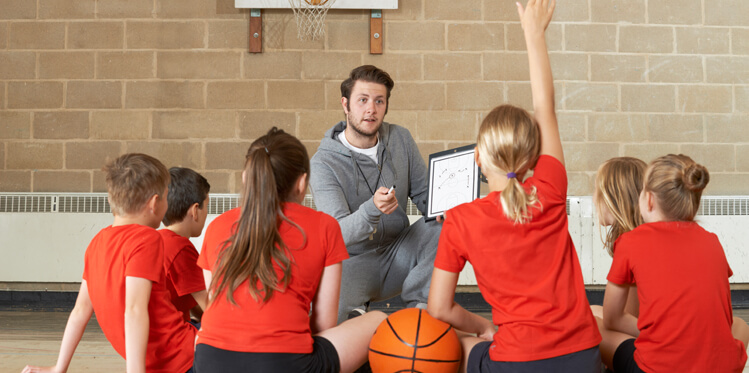I was three years into coaching and delivering PE within primary schools when I first questioned the delivery of my sessions after a visit to a coaching assessment day. Yes, my sessions were always fun and progressive, and 90% of the children within the sessions developed positively – I would say that. But there was a key moment which changed me as a coach, my delivery style, and, more importantly, the way the children participated.
It was nothing technical, obscure or far-fetched. It was as simple as discovering the power of reducing the time you spend talking, stopping, pausing and demonstrating. It was about offering more opportunity of freedom to the children in lessons.
Whilst observing another skilled and experienced coach during a school PE session, our training development officer decided to share with us a particular standout part of his assessment. We watched a very well planned and executed 1 hour session involving 28 Year 4 children participating in a basketball passing drills session. We discovered that out of the whole hour in the session, the children were active and involved for a pitiful 24 minutes.

How was this possible?
The coach leading the session, or any of the other observant instructors including myself, were none the wiser. And why would we be? Completely oblivious and ignorant to the times the children were just stood doing nothing. The overall session from our point of view was very well organised and seemed to flow nicely. The structure of warm up, skills, progression and cool down was still firmly in place and productively followed. The children were all occupied and seemed to enjoy it. However, 36 minutes of actual activity were lost. Every time the coach blew his whistle and shouted for the children to “come in”, each time the coach explained or demonstrated or spoke to the whole group, the number of minutes for each child stood around not being active only increased.
Time to evaluate
The next session I ran, I did nothing different and I approached it in the same way, with the same layout. I was interested in seeing the outcome from a self-evaluating point of view: admittedly I was not far off at all. Taking into consideration the start and end of the session (intro and wrap ups), it was unbelievable the time I spent talking, explaining, stopping and starting whilst trying to create the “perfect session” – and although children were unaware of any of this, it began to ring some very loud alarm bells. If I looked at this way – over the course of 39 school weeks, with each child seeing me once a week for “an hour” – based on the current findings children would miss out on approximately 1,444 minutes of actual activity. Obviously you have to consider weeks where there is game time, or prolonged match situations where activity will last longer, but still this is not acceptable. We either have to stop talking and over coaching, or extend lesson lengths – and I don’t think the latter is a choice.
The children don’t need to be spoken to in great length or in some cases spoken at. The reality is that, once you begin delving further into an explanation of a skill, there will be a combination of children not listening, or not really understanding or taking what you are saying on board. Many coaches love the sound of their own voice and become more irritating and demanding from the children’s point of view. Just take a step back and observe. Let the children have the freedom to enjoy and discover themselves, but DO ensure you are clear and concise with expectations and any lesson/session objectives at the start.
The best coaches and instructors guide the children. It is as simple as setting a task and giving them the ownership and responsibility. Let the children choose their own groups or partners to work with. The reason for this is they will most likely select others that they are comfortable with, and will have most fun with which should enable them to participate more. However, don’t lose control of them and do ensure they are working productively together. You must emphasise this.
I was working on a simple drill for a year one class, it was throwing and catching techniques. Partner A throws to partner B who catches, partner B throws back, and so on. It sounds incredibly simple to us but it’s amazing how complex it could be for a 5 year old. The instruction was pretty straight forward. The children were asked to find a partner, collect a ball, find a space safely and “AWAY YOU GO”. They quickly select a partner and are already feeling comfortable with the working environment as they are probably working with someone they are close to. They now begin to coach and teach themselves. You can see their brains ticking over at a million miles per hour trying to figure out where is the best place to stand? How far apart they should stand to their partner, what hand to use when throwing the ball? What’s the best way to catch a ball? How do they work together with their partner? Their minds are fully engaged whilst they begin focusing on the task in hand.
They began discovering techniques through trying and identifying different skills themselves. Some children would throw overarm, sideways, through legs, underarm and at this stage none of these were wrong. They just had to get the ball to their partner, and this was all happening from a command from me which lasted no longer than 12 seconds.
Trust me, everything is under control. Does it look slightly chaotic? Possibly, but it’s worth it.
I would openly walk around the area stopping a group at a time to focus on. Asking indirect questions really helps. Is there another way of throwing the ball? Can you make your hands a different shape in order to catch the ball better? We could break down the stages and develop individuals without interrupting any other working pair – I would then move on. No more than 20 seconds spent at each group. I was allowing them to self-develop as individuals without having to stop and pause the whole group, reducing the time I spent speaking overall. It would also provide me with an overview of how the progress was going with individuals. Working with smaller groups at a time enabled myself as the coach to set more talented and natural sports players more difficult tasks, and the less developed children easier more attainable tasks. You can’t demand something from a child if they are not ready. You need to guide them in the right direction and make them feel comfortable.
I can confidently raise my hands and say many of my sessions early on were spent talking too much and over-organising the children. Instead of providing the children with the tools to develop themselves I would explain how to do things in too much detail therefore wasting far too much of mine and their time. It’s unbelievable how much more actual activity time you allow the children, and how much quicker you can develop the children and yourself when you maximise the activity time.
Callum Kearns
